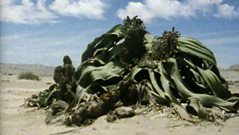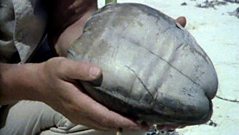
Furnace flora
Where no animals live, desert holly and creosote bushes hack the heat.
David Attenborough is walking through one of the hottest places on Earth - Death Valley in summer at noon. At 94 degrees centigrade the ground is so hot that no animals can live here permanently. They must all seek shelter from the midday sun. But plants can not avoid the sun so they have special devices to help them cope. Desert holly, for example, angles its leaves at 70 degrees to the vertical so that only the edges are exposed to the midday sun. It also extracts salt from the ground and excretes it as a white coating on its leaves to reflect the heat. The creosote bush is one of the most widespread plants in American deserts because it is so good at extracting moisture from the ground. In fact, it is so good at its job that, as the first plant to colonise the Mohave desert, it made it very difficult for any other plant to grow along side it, including its own seedlings. So it grows not by sending out seeds, but by sending out new stems. As these spread outwards the stem in the middle tends to die away and the bush grows into a ring shape. Now some of the creosote rings are over 20 metres across. Some of the creosote plants started growing between 10 and 12 thousand years ago, when the Mohave Desert first came into being. This makes those creosote plants the oldest living organisms in the world.
Duration:
This clip is from
Featured in...
![]()
Βι¶ΉΤΌΕΔ Nature
Be captivated, informed and inspired by the world's wildlife.
More clips from The Baking Deserts
-
![]()
Snare of silk
Duration: 01:48
-
![]()
Ships of the desert
Duration: 03:17
-
![]()
Desert survivor
Duration: 02:25
-
![]()
Big ears
Duration: 01:13
More clips from The Living Planet
-
![]()
Ocean Drifters—Worlds Apart
Duration: 01:20
-
![]()
Snare of silk—The Baking Deserts
Duration: 01:48
-
![]()
Ships of the desert—The Baking Deserts
Duration: 03:17
-
![]()
Desert survivor—The Baking Deserts
Duration: 02:25







